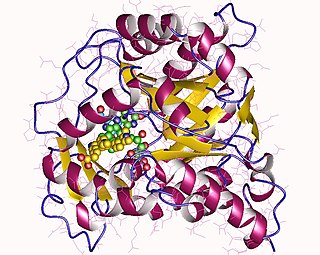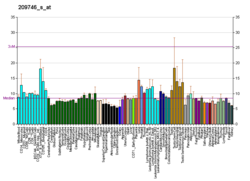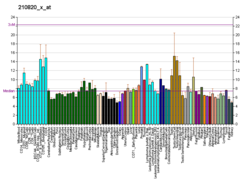
Dihydroorotate dehydrogenase (DHODH) is an enzyme that in humans is encoded by the DHODH gene on chromosome 16. The protein encoded by this gene catalyzes the fourth enzymatic step, the ubiquinone-mediated oxidation of dihydroorotate to orotate, in de novo pyrimidine biosynthesis. This protein is a mitochondrial protein located on the outer surface of the inner mitochondrial membrane (IMM). Inhibitors of this enzyme are used to treat autoimmune diseases such as rheumatoid arthritis.

NADH dehydrogenase [ubiquinone] 1 alpha subcomplex subunit 5 is an enzyme that in humans is encoded by the NDUFA5 gene. The NDUFA5 protein is a subunit of NADH dehydrogenase (ubiquinone), which is located in the mitochondrial inner membrane and is the largest of the five complexes of the electron transport chain.

Decaprenyl-diphosphate synthase subunit 1 is an enzyme that in humans is encoded by the PDSS1 gene.

Para-hydroxybenzoate—polyprenyltransferase, mitochondrial is an enzyme that in humans is encoded by the COQ2 gene.

NADH dehydrogenase [ubiquinone] 1 alpha subcomplex subunit 6 is an enzyme that in humans is encoded by the NDUFA6 gene. The NDUFA6 protein is a subunit of NADH dehydrogenase (ubiquinone), which is located in the mitochondrial inner membrane and is the largest of the five complexes of the electron transport chain.

NADH dehydrogenase [ubiquinone] 1 beta subcomplex subunit 9 is an enzyme that in humans is encoded by the NDUFB9 gene. NADH dehydrogenase (ubiquinone) 1 beta subcomplex subunit 9 is an accessory subunit of the NADH dehydrogenase (ubiquinone) complex, located in the mitochondrial inner membrane. It is also known as Complex I and is the largest of the five complexes of the electron transport chain.

39S ribosomal protein L11, mitochondrial is a protein that in humans is encoded by the MRPL11 gene.

NADH dehydrogenase [ubiquinone] 1 alpha subcomplex subunit 8 is an enzyme that in humans is encoded by the NDUFA8 gene. The NDUFA8 protein is a subunit of NADH dehydrogenase (ubiquinone), which is located in the mitochondrial inner membrane and is the largest of the five complexes of the electron transport chain.

NADH dehydrogenase [ubiquinone] iron-sulfur protein 5 is an enzyme that in humans is encoded by the NDUFS5 gene.

28S ribosomal protein S16, mitochondrial is a protein that in humans is encoded by the MRPS16 gene.

NADH dehydrogenase [ubiquinone] 1 beta subcomplex subunit 1 is an enzyme that in humans is encoded by the NDUFB1 gene. NADH dehydrogenase (ubiquinone) 1 beta subcomplex, 1, 7kDa is an accessory subunit of the NADH dehydrogenase (ubiquinone) complex, located in the mitochondrial inner membrane. It is also known as Complex I and is the largest of the five complexes of the electron transport chain.

NADH dehydrogenase [ubiquinone] 1 beta subcomplex subunit 2, mitochondrial is an enzyme that in humans is encoded by the NDUFB2 gene. NADH dehydrogenase (ubiquinone) 1 beta subcomplex, 2, 8kDa is an accessory subunit of the NADH dehydrogenase (ubiquinone) complex, located in the mitochondrial inner membrane. It is also known as Complex I and is the largest of the five complexes of the electron transport chain.

Ubiquinone biosynthesis protein COQ4 homolog, mitochondrial is a protein that in humans is encoded by the COQ4 gene.

Solute carrier family 25 member 39 is a protein that in humans is encoded by the SLC25A39 gene. The protein has been shown to be necessary for the import of the major antioxidant glutathione into the mitochondria.

28S ribosomal protein S33, mitochondrial is a protein that in humans is encoded by the MRPS33 gene.

aarF domain containing kinase 3 is a protein that in humans is encoded by the ADCK3 gene.
Zoltan Vajo is a Hungarian/American scientist, best known for his contributions to the Human Genome Project, including cloning the COQ7 gene, characterizing the human CLK-1 timing protein cDNA and its potential effect on aging, and research on the molecular and genetic background of skeletal dysplasias and fibroblast growth factor receptor 3 disorders, including Achondroplasia, SADDAN, Thanatophoric dysplasia, Muenke coronal craniosynostosis and Crouzon syndrome as well as more recently on genetically engineered insulin analog molecules, including their structure, metabolic effects and cellular processing and the role of recombinant DNA technology in the treatment of diabetes.

Ubiquinone biosynthesis protein COQ9, mitochondrial, also known as coenzyme Q9 homolog (COQ9), is a protein that in humans is encoded by the COQ9 gene.

Decaprenyl-diphosphate synthase subunit 2 (PDSS2) is a protein that in humans is encoded by the PDSS2 gene.
Catherine Clarke is an American biochemist who is a Professor of Chemistry at the University of California, Los Angeles. She was the first woman to serve as Head of the Department of Chemistry and Biochemistry. Her research considers the functional roles of Coenzyme Q.



















